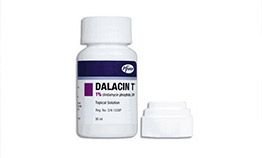
All iLive content is medically reviewed or fact checked to ensure as much factual accuracy as possible.
We have strict sourcing guidelines and only link to reputable media sites, academic research institutions and, whenever possible, medically peer reviewed studies. Note that the numbers in parentheses ([1], [2], etc.) are clickable links to these studies.
If you feel that any of our content is inaccurate, out-of-date, or otherwise questionable, please select it and press Ctrl + Enter.
Dalacin T
Medical expert of the article
Last reviewed: 03.07.2025

Dalacin T is a topical antimicrobial drug used to treat inflammatory skin conditions and acne.
The medication is intended for external local use only. When absorbed into the skin, the active substance can have a systemic effect. Like most antibiotics, Dalacin T can cause stool disorder and intestinal inflammation, but with local use, this side effect of the body develops extremely rarely.
ATC classification
Active ingredients
Pharmacological group
Pharmachologic effect
Indications Dalacin T
Dalacin T is prescribed for inflammation of the sebaceous glands (acne vulgaris).
 [ 1 ]
[ 1 ]
Release form
Dalacin T is available as a transparent gel for external use. The drug contains clindamycin (an analogue of lincomycin), which has a fairly narrow range of antimicrobial activity.
 [ 2 ]
[ 2 ]
Pharmacodynamics
Dalacin T is a semi-synthetic antibiotic of the lincosamide group. The active substance, clindamycin, is active against acne propionibacteria, which are the main causes of acne and skin inflammation.
Clindamycin has no antifungal activity.
 [ 3 ]
[ 3 ]
Pharmacokinetics
Dalacin T was tested on an extract from the contents of acne. Clinical studies have shown that topical use of the drug can suppress the proliferation of bacteria that cause inflammation and acne on the skin.
The gel reduces the level of free fatty acids. Regular use of Dalacin T leads to a slight increase in the level of clinlamycin in blood plasma and urine.
 [ 4 ]
[ 4 ]
Dosing and administration
Dalacin T is applied to acne-prone and inflamed areas of the skin in a thin layer. The gel should be applied twice a day to clean skin.
 [ 7 ]
[ 7 ]
Use Dalacin T during pregnancy
The effect of Dalacin T during pregnancy has not been studied. There is also no data on whether clindamycin penetrates into breast milk when applied topically.
Contraindications
The medication is not prescribed for people with high sensitivity to clindamycin or lincomycin, as well as other components of the drug.
Side effects Dalacin T
Shelf life
Dalacin T is valid for two years from the date of manufacture, provided that storage conditions are met and the packaging is intact.
Manufacturer
Attention!
To simplify the perception of information, this instruction for use of the drug "Dalacin T" translated and presented in a special form on the basis of the official instructions for medical use of the drug. Before use read the annotation that came directly to medicines.
Description provided for informational purposes and is not a guide to self-healing. The need for this drug, the purpose of the treatment regimen, methods and dose of the drug is determined solely by the attending physician. Self-medication is dangerous for your health.

